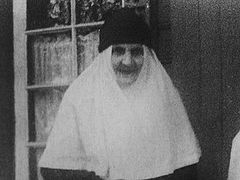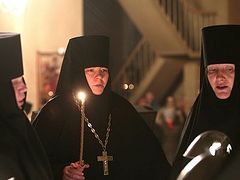A special place, or, if you like, a special kelli [monastic cell—Trans.] in my memory is occupied by two schemanuns of Pukhtitsa Monastery: Schemanun Alexia and Schemanun Maria. They were the first living schema monastics I had ever seen. They slowly moved through the church and around the monastery, each accompanied by a novice, leaning now on the novice’s hand, now on a staff, or both at once. In their special black and white schema habits with crosses, as if in funeral shrouds, they inevitably attracted the curious glances of tourists and neophytes, like I was in the long-ago late 1970s.
In the monastery they said that Mother Alexia was one of the orphan girls that lived in the orphanage of Princess Elizabeth Shahovskaya on the nearby hill.1 She entered the monastery straight from the orphanage, and after many obediences, she was assigned to the position of monastery dean. Many sisters remember her as young, tall, and of a strong constitution. It was hard for me to imagine her that way, because when I first saw her, she was already a slender, small, and slouching elderly nun. At the same time, the noble softness of her face attracted me. Her lively brown eyes radiated kindness, and her whole appearance had an unfailingly friendly attitude towards everyone—even the ill-mannered tourists who shamelessly stared at her with unabashed curiosity.
However, I was most struck by the sisters’ story about how Mother Alexia, having spent her entire life in the monastery, never went beyond its borders. On the one hand, trying to “digest” such a rare biographical fact, I thought it was understandable: She was an orphan—where did she have to go; to whom? But did she really not want to see how traffic flows through the streets and people scurry to and fro in large and noisy cities, at least once, if only to be convinced of the correctness of her chosen path? Or was it enough for Mother Alexia’s observant gaze to meet the world in the face of pilgrims and tourists—which she could see every day in the monastery—and to hear the stories of the sisters about secular life (and many of them had something to tell about the joys and woes of life in the world)?
In short, trying to logically explain this startling fact to myself further deepened the feeling of respect I felt for Mother Alexia from the very beginning. She ended her schema life when I was still serving as a deacon at the monastery, and I was able to participate in her funeral and burial in the monastery cemetery. Immediately after her burial, Fr. Germogen had to read the appointed prayers in the vacant cell of the reposed Mother Alexia and he allowed me to go with him. It was a small, fairly bright room with two windows facing the northeastern side of the Dormition Cathedral. Shelves of ascetical books and plenty of icons on the walls caught my eye as soon as I crossed the threshold. As I left Mother Alexia’s temporarily empty cell, I reflected that someone had lived here before Mother Alexia and someone will occupy this cell again, with a view of the cathedral, practically under the monastery’s gate bell tower, and that perhaps it will be that way until the end of the age—and this calmed my soul.
As for Schemanun Maria, she lived in a cell on the northwest side of the cathedral, and her window, like Schemanun Alexia’s, looked out on the cathedral, so she could see everyone entering and leaving the cathedral through its main western gate. Schemanun Maria was as small as Schemanun Alexia, only, perhaps, more broad-boned. Her face didn’t seem as expressive as Schemanun Alexia’s to me; but still, her look and smile were also kind and welcoming, and at the same time, there was a certain detachment from all earthly things in her face. Schemanun Maria had a noticeable hobble in her walk, which you might not have paid much attention to given her age, if you didn’t know the story of how this limp appeared.
It turns out that as a child, the future Schemanun nearly lost her leg from some dangerous disease. Her parents, greatly concerned about their daughter’s sickness, took her from one notable doctor in St. Petersburg to another, but the disease did not recede; on the contrary, it progressed. Finally, one of her parent’s friends advised them to immediately go to Kronstadt for help, to Fr. John Sergiev. Fortunately, her faithful parents were well aware of who Fr. John was and where to find him, and they made haste to go to Kronstadt. Fr. John treated the sick girl and her parents with his usual compassion. As was his custom in such cases, he immediately celebrated the rite of the Little Blessing of Water and after a long prayer, and having blessed the child, he foretold that she would recover but would have a bit of a limp. And that is what happened.
When I heard this story from one of the Pukhtitsa sisters, I couldn’t help but notice Mother Maria’s limp and look at her uneven gait as a miracle. Those wonderful words from the Gospel about the struggle with sinful thoughts, which the Lord adorned in the form of a parable, always come to mind: And if thy foot offend thee, cut it off: it is better for thee to enter halt into life, than having two feet to be cast into hell (Mk. 9:45). It seems it’s not easy to walk gracefully into the Kingdom of Heaven. So Schemanun Maria “hobbled” her way to salvation, as evidenced, for me, by her external, physical limp.
Much later, serving in a parish, I had to serve the funeral of one of our parishioners who lost one eye due to a serious illness not long before her repose. At the Liturgy in the church that day before the funeral (it so happened, and many people noticed this amazing coincidence), we read the appointed passage in the Gospel of Mark where it says: And if thine eye offend thee, pluck it out: it is better for thee to enter into the Kingdom of God with one eye, than having two eyes to be cast into hell fire (Mk. 9:47). This parishioner also traversed his path of renouncing worldly temptations, that is, in the language of the parable, he “plucked out his eye”; and then, enduring a severe illness without murmuring, he was vouchsafed a Christian end. Reflecting on these and similar Christian fates, you involuntarily recall the words of the last will and testament of Archimandrite John (Krestiankin): “God knows how to save those who love Him.”




